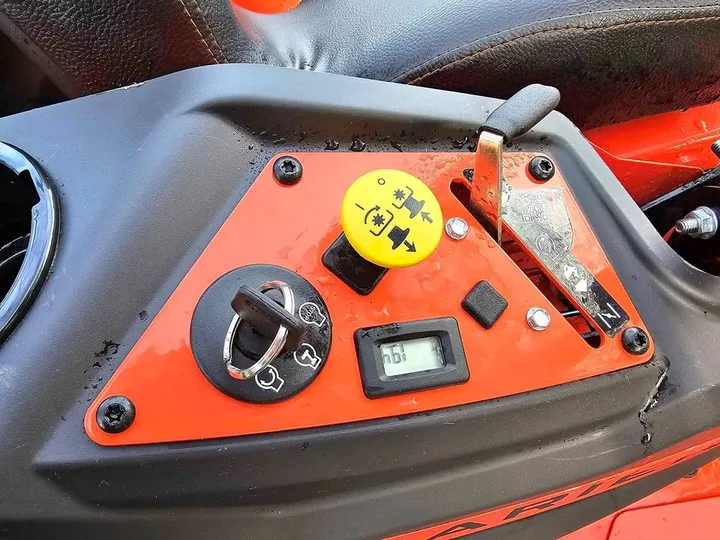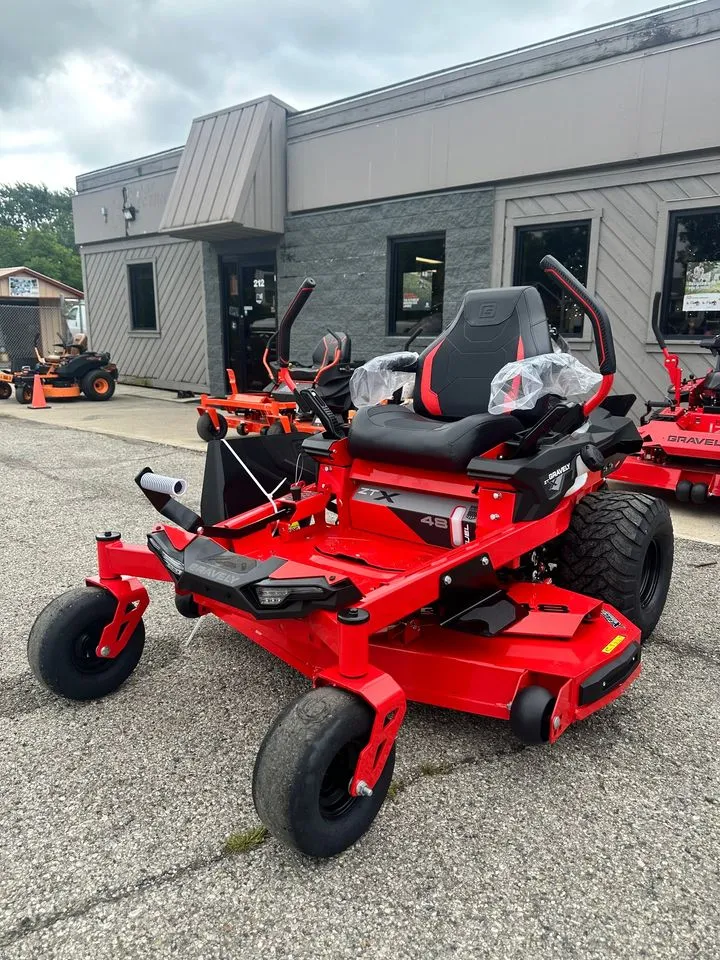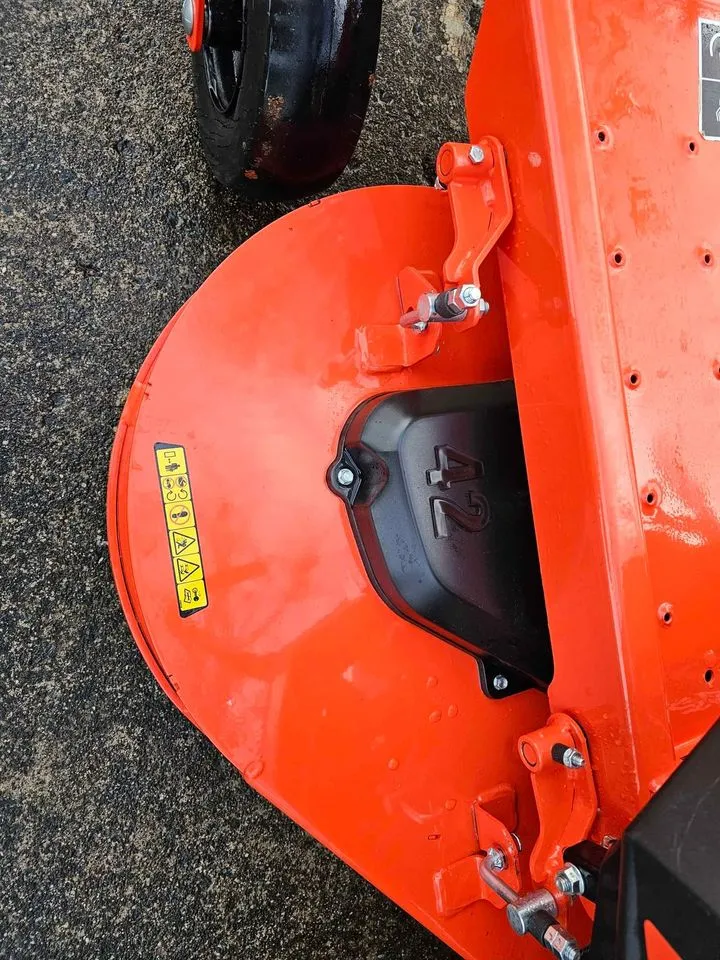As a seasoned expert with years of hands-on experience in landscaping equipment, particularly Gravely zero turn mowers, I offer a deep understanding of their common problems.
My knowledge is grounded in practical, real-world use and maintenance of these mowers.
In this article, you’ll find concise, valuable insights into troubleshooting and resolving issues specific to Gravely zero turn mowers.
My aim is to equip you with reliable information and solutions, ensuring you can confidently address any challenges you may encounter with your mower.
Quick Summary
- Typical problems with Gravely zero turn mowers include difficulty in starting, excessive smoke, inefficient hydrostatic transmission, and gasoline leakage, each with specific troubleshooting steps.
- Regular maintenance, including routine cleaning and inspections, is crucial to preventing common issues such as starting difficulties and uneven cutting in Gravely zero turn mowers.
- Approximately 50% of lawn mower problems are attributed to the accumulation of dirt and debris, highlighting the importance of consistent cleaning and maintenance.
- From my experience, investing time in understanding and maintaining your Gravely mower can significantly reduce the likelihood of encountering these common issues.
Typical Issues with Gravely Lawn Mowers and Their Fixes
I’ve encountered my fair share of problems with Gravely lawn mowers, and I’m eager to share some fixes.
Let’s tackle these common hiccups, from excessive smoke to hydrostatic transmission woes, and get your mower back on track for a smooth ride.
- Difficulty in Starting
- Initiates but Shuts Down Shortly After
- Excessive Smoke from Mower
- Inefficient Hydrostatic Transmission Performance
- Problems with Straight Driving or Steering
- Lack of Movement
- Excessive Vibration During Operation
- Poor or Inconsistent Cutting Quality
- Gasoline Leakage Issues
Related Articles:
Difficulty in Starting
When a Gravely lawn mower experiences difficulty in starting, it is essential to systematically identify the root cause of the issue.
The process begins by examining several key components of the mower:
- Battery Check: The initial step involves inspecting the battery. A fundamental cause for starting issues can be a battery that is either dead or weak. The battery needs sufficient charge to turn the engine over. Indicators of a battery problem include no response when turning the ignition key, or a slow cranking sound that fails to start the engine. It’s important to ensure that the battery is not only charged but also properly connected.
- Spark Plug Inspection: The next focus is the spark plug, a critical component for engine ignition. A spark plug in poor condition can prevent the engine from starting. Signs of a spark plug issue include visible dirt or corrosion on the plug, a cracked porcelain insulator, or an electrode that is burnt away or heavily coated with carbon. A clean, intact, and properly gapped spark plug is essential for the engine to fire up.
- Fuel System Examination: The final major checkpoint is the fuel system. This involves looking for signs of old or contaminated fuel, which can lead to clogs in the carburetor, impeding the starting process. Symptoms indicating fuel system issues include a stale or sour gas smell, visible dirt or residue in the fuel tank, or difficulty in starting despite a good battery and spark plug. It’s also crucial to check the choke setting; an improperly set choke can prevent the engine from starting. A choke that is either fully open or closed when it shouldn’t be can be a sign of this issue.
Initiates but Shuts Down Shortly After

When a Gravely lawn mower starts up but then shuts down abruptly, several potential malfunctions could be the cause.
Identifying the issue requires a systematic inspection of various components:
- Fuel Pump Check: The initial step is to examine the fuel pump. A mower that starts but shuts down soon after may be experiencing fuel flow problems. Signs of fuel pump issues include a sputtering engine before it shuts off, indicating inconsistent fuel delivery. Checking for clogs or physical damage to the fuel pump is essential, as these can impede the fuel flow to the engine.
- Ignition Coil Testing: The ignition coil should be the next focus. A faulty ignition coil can cause the engine to shut down suddenly after starting. Symptoms of a malfunctioning ignition coil include intermittent starting issues and an engine that starts but quickly dies. Testing the ignition coil involves checking if it’s providing a consistent spark necessary for the engine to keep running.
- Carburetor Examination: Another potential culprit is the carburetor. If it’s not mixing fuel and air properly, the engine may start but then shut down. Indicators of carburetor issues include rough running before the engine shuts off, or a mower that only runs when the choke is engaged. This suggests that the carburetor may require cleaning or adjustment.
- Air Filter Inspection: The air filter should also be inspected. A dirty air filter can restrict airflow to the engine, effectively suffocating it and causing a shutdown soon after starting. Visible dirt, clogging, or damage to the air filter are key signs to look for. A clean air path is crucial for proper engine operation.
- Engine Oil Level Check: Lastly, checking the engine oil level is critical. Low oil levels can cause the engine to overheat and automatically shut down to prevent damage. Indicators of low oil can include an overheating engine shortly after starting, or the oil warning light flickering before the engine shuts off. Ensuring the oil is at the right level and in good condition is essential for the mower’s operation.
Excessive Smoke from Mower
When excessive smoke is emitted from a lawn mower, it’s often an indicator of either an oil-related issue or a problem with the air-to-fuel mixture.
To identify the specific cause, a systematic examination of several key components is necessary:
- Oil Level Check: The first step is to assess the oil level. Excessive oil in the engine can lead to its burning, which typically results in white or blue smoke. Signs that suggest an oil level issue include smoke with a distinct oily smell, or an oil level that reads well above the ‘Full’ mark on the dipstick. It’s crucial to ensure the oil level is within the recommended range.
- Air Filter Inspection: The next focus should be on the air filter. A clogged or dirty air filter can restrict the engine’s airflow, disrupting the air-to-fuel ratio. This imbalance often causes black smoke to be emitted from the mower. Visible signs of a clogged air filter include dirt, debris, or a filter that appears saturated with oil or fuel. Ensuring a clean and clear air filter is vital for proper engine function.
- Fuel Quality Examination: Another potential cause of excessive smoke is the quality of the fuel. Old or contaminated fuel can affect the combustion process, leading to smoke production. Symptoms of fuel-related issues include smoke that appears shortly after refueling or a change in the mower’s performance following the use of a new fuel source. Draining old or suspicious fuel and replacing it with fresh, high-quality fuel can often resolve this issue.
Inefficient Hydrostatic Transmission Performance
When a Gravely mower experiences inefficient hydrostatic transmission performance, it can significantly impact its overall functionality.
To identify the issue, it’s essential to inspect several critical components of the hydrostatic transmission system:
- Hydraulic Fluid Level Check: The first step in addressing this issue is to examine the hydraulic fluid level in the transmission system. Low fluid levels can severely affect transmission efficiency and lead to poor mower performance. Signs of low fluid may include erratic or sluggish movement of the mower. If the fluid level is below the recommended range, it needs to be topped off to ensure the system functions optimally.
- Drive Belt Inspection: The next focus is on the drive belt, which plays a vital role in engaging the hydraulic pump. A compromised or worn-out drive belt won’t properly transfer power to the hydraulic pump, resulting in reduced mower performance. Indicators of a worn belt include visible damage, fraying, or slipping when engaging the transmission. Checking the drive belt’s condition is essential to ensure it’s in good shape and functioning correctly.
- Leak Detection: It’s crucial to be vigilant for any signs of hydraulic fluid leaks within the transmission system. A leak can lead to a drop in hydraulic pressure, causing the mower to become sluggish and less responsive. Signs of a leak may include visible fluid stains or puddles beneath the mower, or a noticeable reduction in hydraulic fluid levels over time. Identifying and fixing any leaks promptly is essential for maintaining optimal hydrostatic transmission performance.
Related: Gravely Zero Turn Hydraulic Problems
Problems with Straight Driving or Steering

When a Gravely mower experiences issues with straight driving or steering, it can impact its maneuverability and overall performance.
To identify the problem, it’s essential to inspect various components related to the steering and control systems:
- Alignment and Steering Component Check: The first suspicion in this scenario is misalignment or wear in steering components. Signs of misalignment include the mower veering off course or having difficulty maintaining a straight path. Worn-out steering components can result in erratic steering behavior. This issue often indicates problems with the hydraulics or hydrostatic drive system. A valve that isn’t functioning correctly could affect the fluid flow, which is essential for maintaining smooth steering control.
- Unusual Vibration Examination: In addition to checking alignment and steering components, it’s important to be attentive to any unusual vibrations. Unusual vibrations can indicate problems with dampers, which are crucial for absorbing shocks and keeping the ride stable. Excessive or irregular vibrations can result in erratic steering responses and an uncomfortable ride. Regular maintenance is key to ensuring that dampers are in good condition and functioning properly.
Lack of Movement
When a Gravely zero turn mower fails to move, it often indicates a problem with the transmission or the drive belt system.
To identify the issue, a systematic inspection of several key components is necessary:
- Transmission Fluid Check: If the mower is equipped with a hydrostatic transmission, it relies on hydraulic fluid for movement. The first step in diagnosing the issue is to check the transmission fluid level. Low or contaminated fluid can lead to a lack of movement. Signs of low fluid may include sluggish or unresponsive mower behavior. Topping off or changing the hydraulic fluid is a straightforward fix if it’s determined to be the cause of the problem.
- Drive Belt Inspection: If the transmission fluid level is not the issue, the next focus should be on the drive belt. A slipped or broken drive belt can prevent the transfer of power from the engine to the wheels, resulting in a lack of movement. Indicators of a belt problem include visible damage, fraying, or slackness in the belt. Replacing the drive belt is typically the solution to this issue.
- Pump Examination: In the worst-case scenario, when neither the transmission fluid nor the drive belt is the culprit, it’s essential to inspect the pump responsible for powering the transmission. A failing pump can lead to a complete lack of movement. Signs of a failing pump include unusual noises, such as whining or grinding, coming from the transmission area. Replacing a faulty pump is a more complex task and usually requires professional intervention.
Excessive Vibration During Operation
Excessive vibration during the operation of a Gravely mower is an issue that can affect its performance and comfort.
To identify the problem, it’s crucial to inspect various components related to the mower’s blades, spindle assembly, and engine mount:
- Blade Inspection: The first step when experiencing excessive vibration is to turn off the mower and inspect the blades. Look for any signs of damage or wear on the mower blades. Bent or dinged blades can become unbalanced, leading to significant vibration during operation. It’s important to ensure that the blades are in good condition, with no visible signs of damage.
- Pulley and Clutch Examination: After checking the blades, it’s essential to take a closer look at the pulleys and clutch. Ensure that these components are secure and functioning correctly. Loose or damaged pulleys and clutch mechanisms can also contribute to excessive vibration. Inspecting them for any signs of wear, misalignment, or damage is crucial to resolving the vibration issue.
Poor or Inconsistent Cutting Quality

When a Gravely mower leaves behind a patchy lawn or produces unevenly cut grass, it indicates a problem with its cutting performance.
To identify the issue, a systematic inspection of several key components is necessary:
- Blade Check: The first step in troubleshooting poor cutting quality is to inspect the mower blades. Dull or damaged blades are often the culprits behind uneven cuts and a patchy lawn. Blades that cannot slice through grass cleanly can result in an inconsistent cutting pattern. It’s essential to maintain sharp blades and make it a regular practice to sharpen or replace the blades as needed to ensure the best mowing results.
- Deck Leveling Examination: Next, it’s crucial to examine the mower’s deck to ensure that it is leveled correctly. An unlevel deck can lead to inconsistent cutting, as it causes the blades to cut at varying heights. Signs of an unlevel deck include uneven grass heights and an uneven lawn appearance. Properly leveling the deck is essential for achieving a uniform and attractive lawn.
- Clipping Inspection: Another aspect to consider is the presence of clogged clippings under the deck. Clippings that accumulate and block the airflow can disrupt the cutting pattern and lead to poor cutting quality. Signs of clogged clippings may include clumps of grass left behind or visible obstructions beneath the deck. Regularly cleaning out clippings from under the deck is necessary to maintain an optimal cutting performance.
Gasoline Leakage Issues
Gasoline leakage is a common issue that can occur with Gravely lawn mowers, posing both safety risks and affecting the mower’s performance.
To identify the issue, it’s crucial to inspect several components that could be contributing to the leakage:
- Fuel Tank Examination: The first step when dealing with gasoline leakage is to inspect the mower’s fuel tank. Gasoline leaks can often originate from a compromised fuel tank, which may have cracks or damage. The presence of ethanol in gasoline can exacerbate this issue by corroding the material of the fuel tank. Signs of a leaking fuel tank may include visible gasoline stains or puddles beneath the mower. Careful examination of the fuel tank is necessary to identify any cracks or damage.
- Carburetor Inspection: Another potential source of gasoline leakage is the carburetor, often referred to as the “carb.” Ethanol-laden gasoline can deteriorate the seals within the carburetor, leading to leaks. It’s essential to inspect the carburetor for any signs of wear or damage, particularly around the seals and gaskets. The presence of gasoline around the carburetor can be an indication of a leak.
- Preventative Maintenance: To prevent gasoline leakage issues, it’s advisable to perform regular maintenance on the mower. This includes using ethanol-free gasoline, which reduces the risk of corrosion and deterioration of fuel system components. Additionally, inspecting the fuel system, including the fuel tank and carburetor, as part of routine maintenance can help detect and address potential issues before they lead to leaks.
Our Verdict
In my journey with Gravely zero turn mowers, I’ve encountered a spectrum of issues, from starting difficulties to uneven cutting. My experience has taught me the invaluable role of regular maintenance – it’s the cornerstone of keeping your mower in top shape.
Personally, I’ve found that staying ahead of maintenance schedules and understanding the nuances of my mower’s needs significantly reduces the frequency of these problems.
Remember, a well-maintained mower not only saves you from future hassles but also ensures your lawn remains the envy of your neighborhood.
So, from my own experiences, I strongly advocate for consistent care and attention to your Gravely mower – it truly makes all the difference!
Frequently Asked Questions
How does the warranty coverage of Gravely zero turn mowers compare to other brands in the market?
I’ve noticed that the warranty coverage for Gravely zero turn mowers is quite competitive compared to other brands, offering comprehensive protection for various parts and labor for several years.
Are there any specific environmental conditions under which Gravely zero turn mowers tend to have more problems?
I’ve noticed that my mower struggles in wet conditions and extreme heat. These environments seem to cause more issues, like clogging and overheating, which affect its overall performance and durability.
How does the use of aftermarket parts affect the performance and longevity of Gravely zero turn mowers?
I’ve found that using aftermarket parts can sometimes decrease my mower’s performance and may lead to more frequent repairs, potentially shortening its overall lifespan compared to using original manufacturer parts.
What are the most common operator errors that could lead to issues with Gravely zero turn mowers?
I often see people making mistakes like improper starting procedures, ignoring maintenance schedules, or misjudging terrain which can cause significant issues with their mowers over time. It’s crucial to follow the operator’s manual closely.
Can software updates or recalibrations be performed by the owner, or do they need to be conducted by a professional service technician?
I can update some software myself, but recalibrations often require a professional technician to ensure they’re done correctly. It’s best to check the mower’s manual or contact customer support for guidance.


